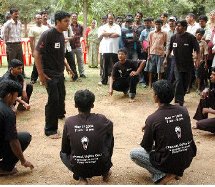My tryst with animation started when I was 12. And today, even though I’m exactly two weeks into adulthood, just about nothing can compel me to deny that I would still prioritize an “Igor” over an “Angels and Demons”.
So, when Happy Feet was released three years back, all my classmates were aware of my “hippity-hoppity” love for Mumble, the un-Emperor like Penguin.
The child in me is till date, echoing its desire to be taken to Antarctica to be able to catch a glimpse of the tuxedoed species, to be able to imitate their noisy flapping action, to be able to nose fight with their protruding beaks and to be able to feel their happy feet!
However, the situation that Mumble, Gloria, Rockhopper and the others in their family are witnessing is a grave bargain. The world is getting warmer but the temperatures are increasing five times faster than the world average in this continent, which is home to a million penguins. The dinner-jacketed penguins are unfortunately, the first to feel the impact. And why is it almost impossible to ignore what’s happening to this species? Because this, my friend, is only a foretaste of things to come, an early indication of what may be happening to other species. The penguins are not the only sufferers of the massive climate change but sadly, are amongst the first apparent victims of the disaster following Global Warming!
As always, Google came to my rescue and has allowed me to consolidate numerous facts about the impending extinction, of the “dinner-jacketed goofballs”. They say that in the changing scenario each species in the world has two options; they can either evolve or die out. There isn’t much to link penguins to the former, because in a situation where the “hot is becoming hotter”, the penguins don’t have anywhere to migrate!
With the unavailability of food-rich waters, the loss of nesting sites, which mind you, have more than a single cause to the shrinking levels of ice, there is not even a single factor favoring their survival. As a simple analogy, it’s almost like the Adelies, the Emperors, the Chinstraps and the Gentoos, took the same route, landed at a four way crossing and none saw the green signal!
The penguins usually munch on krill and fish, their staple diet. Now, due to a disrupted food chain and the continuous melting of ice, neither is available to the penguins, preventing them from gulping food down their wobbly throats. Did you know that an average penguin can manage to cover a mere mile in an hour! Imagine a situation where the hefty creatures have to walk 30 miles to get food because the Ross Sea witnessed two humongous ice bergs melting down only to park themselves between the breeding colonies and the feeding areas, none of which can a penguin sideline!
As peculiar as it may sound, the Adelie penguins only breed on land without ice and snow. Heavier and more frequent snowfalls have resulted in a dramatic decrease in their population. Moreover, its cousins, the Gentoos and Chinstraps have ironically invaded their territory. But the lack of food has made all four stand at cross roads.
Since theory must always be backed by facts, listed below are some alarming figures, which have caused the wiping off of numerous penguin colonies.
#1. In the Antarctic Peninsula temperatures have risen by 5 degree Celsius in the last 50 years. I know, you’re thinking that 50 years is a long time. But get back to reality and hope for added disaster by the time you retire.
#2. Since the temperatures have risen, the population of the Adelies’ has declined by almost 50 percent. It’s almost like the lives of half your own family is in jeopardy.
#3. Their cousin, the Chinstraps have begun to decrease by 30-66%, who in spite of the warmer, more suitable climate have been losing their young ones to lack of food.
#4. Globally, it has been assumed that, the earth will start to lose more than 1 million species of animals, starting from now till 2050. The penguins have started the count and the census will very well include us, Homo sapiens!
#5. It will not be a shock when summer, winter, spring and autumn are renamed because it has been estimated that the combination of climatic conditions on 10%-48% of the planet will have disappeared altogether!
In a situation which has now started to climb the peak of disaster in a manner as brisk as possible, ignoring it becomes a crime and implementing a basic action becomes a means of saving your own life. In hindsight, not just the penguins, but a thousand more species, both known and unknown, will constitute the book of extinction. Are we still waiting in the hope that the murderer is unarmed? Spare me the task of reminding you, because it’s high time that each one of us does this for ourselves.
Even though the child in me might not be able to have its “Rendezvous with Mumble”, I’d never want the little kid dying out herself.



